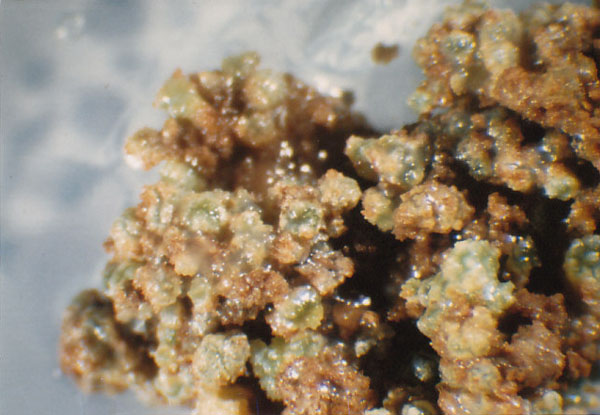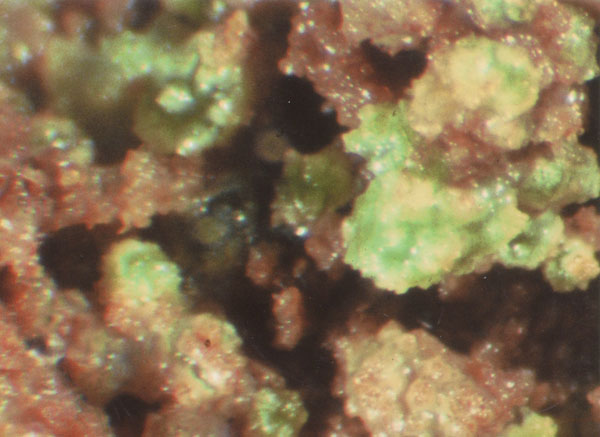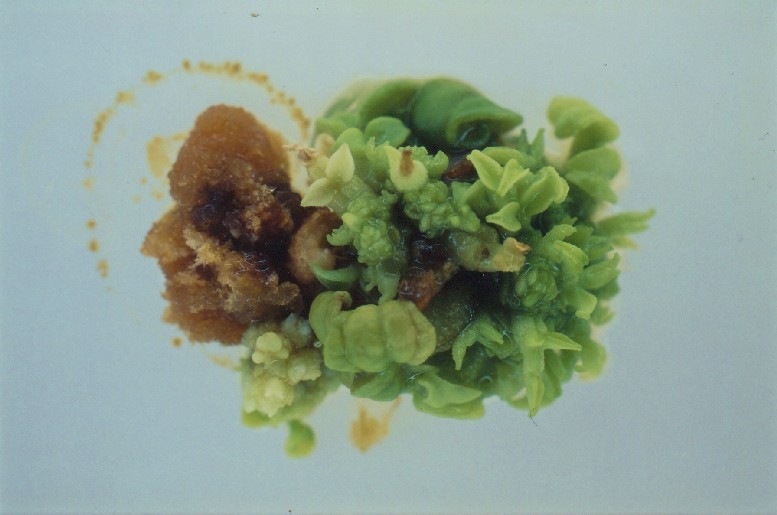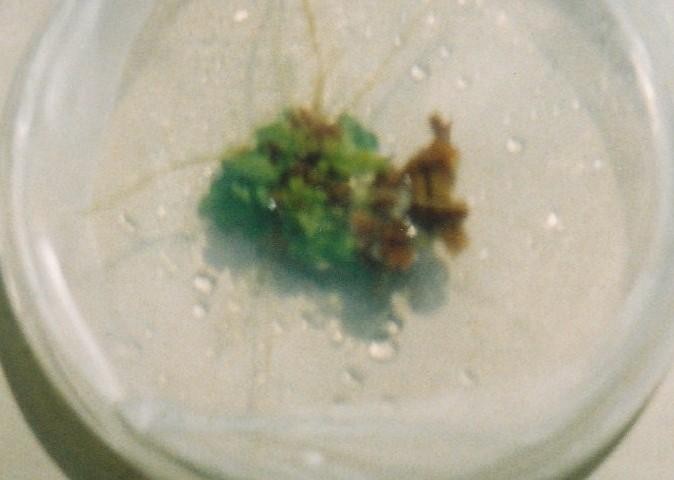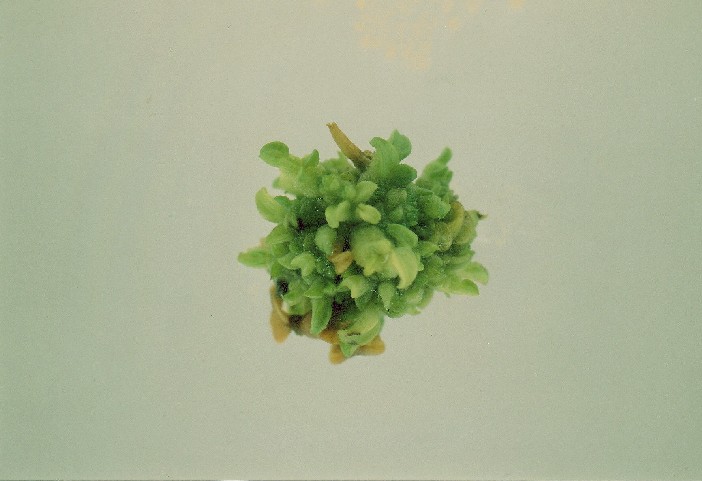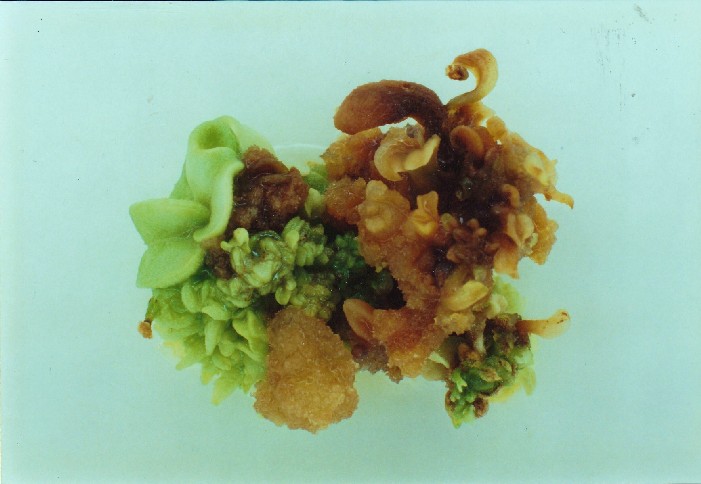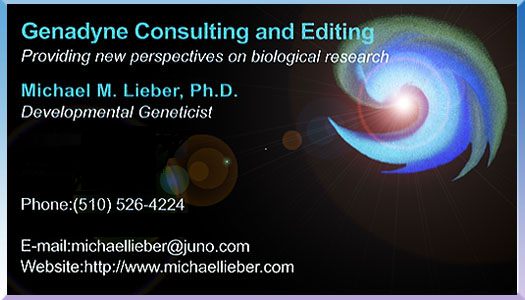|
|
|
|
REVIEW/PERSPECTIVE
Using classical or traditional plant growth regulators, calli or plant tumors have been produced in vitro and subsequently have been induced to produce buds and plantlets, a process referred to as regeneration. For many years, this has been a successful procedure for in vitro plant propagation. However, for a number of plant species, investigators could not induce calli in vitro to produce buds. Organogenesis was still recalcitrant for various plants in 1980. New types or non-conventional growth regulators, such as methylglyoxal and ascorbic acid, were then found to overcome recalcitrant organogenesis in vitro. Their successful or effective use gave support to a theory that stressful, non-uniform cohesive fields, occurring through the application of certain chemicals, are necessary for in vitro morphogenesis from plant neoplasm or callus. Morphogenesis was seen as an adaptive accommodation to the inner stresses from such non-uniform, cohesive forces. In general, diverse chemicals, not considered traditional plant growth regulators would act morphogenically, it has been conjectured, by enabling the generation of such non-uniform fields, and it has been predicted that more will be discovered. A new constructive approach to agriculture and medicine, using a new plant-tissue culture model, based on new theory, has also been predicted. Key words: growth regulators, callus, tumors, recalcitrant, organogenesis, morphogenesis, nonconventional, non-classical, methylglyoxal, ascorbic acid, cohesive fields, new theory
1. Introduction: In Vitro Plant Propagation
For given plant species, such as tobacco and carrot, this method to induce regeneration worked very well. However, for other plant species, such as pine, one could not induce the callus to generate buds and shoots. This limitation has been referred to as recalcitrant organogenesis. To circumvent this problem in early 1980, a new approach was thus required. It was thought that by inducing stressful, non-uniform cohesive fields within regions of the recalcitrant callus an adaptive, complex response in the form of organogenesis would ensue in those regions (Lieber, 1995, 1996 PDF). It was also conjectured that the callus or plant tumor contained repulsive forces as a source of dedifferentiation, and that such repulsive forces had to be overcome with the establishment of cohesive forces in order for the differentiation and morphogenetic process to be enabled. Auxins such as naphthalenacetic acid (NAA) were conjectured as generating repulsive forces within organized plant tissue, leading to their de-differentiation and the production of callus.
Methylglyoxal with
ascorbic acid was found by Szent-Gyorgyi (1965, 1978, and 1980) to
create cohesive forces within animal tumors, resulting in the inhibition
of their growth and their eventual necrosis. Normal tissue was found not
to be affected. According to Szent-Gyorgyi’s investigations,
carcinogenesis is due to the cessation of cohsesive forces in nornal,
differentiated tissue and an associated loosening, which could account
for the metastatasis of cancerous tissue. The establishement of
repulsive forces in such tissues, as well as in neoplastic plant
callus, also cannot be ruled out as a contributing factor. The author
conjectured that methylglyoxal and ascorbic acid would also enable the
establishment of cohesive fields within plant callus regions, resulting,
through these stress fields, in an adaptively responsive morphogenesis
(Lieber, 1995, 1996). Hence, experiments were undertaken with pine calli
to determine whether or not methylglyoxal with ascorbic acid, as
non-classical or nonconventional growth regulators, can be used to
overcome recalcitrant organogenesis. If this were found to be the case,
it would strongly suggest that the induction of, and response to,
non-uniform cohesive fields within
callus is a necessary parameter for differentiation and morphogenesis.
It would further indicate that this could be done through the
application of various chemicals, including the classical growth
hormones such as the cytokinins, e.g., 6- benzylaminopurine (BAP). In
this way, the cohesive-field field hypothesis could be tested while
discovering an effective method for overcoming recalcitrant
organogenesis, or more generally, recalcitrant morphogenesis.
Tumors or calli were derived from needles of Pinus taeda and subcultured onto a culture medium containing methyglyoxal at 1.38 uM and ascorbic acid at 10 mg/L. With this species, methyglyoxal (MG) and ascorbic acid (C) enabled the development of many buds via organogenesis from pine neoplasm (callus) derived from needles, somatic tissue, while greatly inhibiting the growth of the callus, (Lieber, 1995, 1996). This occurred without the presence of classical plant growth hormones, such as BAP, in the culture medium. Though originally green, the buds eventually deteriorated and became necrotic while remaining on the MG medium. Some, however, remained green. (See Figure 1b) Figures 15a and 15b, at the end of this article, show many of the deteriorated buds that developed from the needle callus. Note, however, the well-developed, non-deteriorated bud in the middle of Figure 15b. The general culture medium used by the author in his investigations was MS (Murashige & Skoog, 1962) with glutamine present as the nitrogen source in some experiments rather than ammonium nitrate and potassium nitrate. In experiments conducted in 1979-1980, cultures, such as calli, were grown at 22o centigrade, with a photo-period of 16 hours. In experiments conducted during 1991-1994, cultures were grown at 25o centigrade. Photo-period was still 16 hours. At the time, early 1980, when this was first observed, one did not know that by accumulating to a high degree in the bud tissue, MG can cause such deterioration. Only in subsequent investigations 12 years later, did this become recognized (Lieber, 1996). In retrospect, in order to have precluded such accumulation, one should have subcultured such bud cultures, while still green, onto growth media without MG, but containing BAP at various levels and with C at various levels. Subsequent investigations with another pine species in 1991-1992, Pinus muricata, again showed that MG at 0.1 mM with C at 10 mg/L induced or enabled morphogenesis from pine needle callus (Lieber, 1996). The photo in the publication shows morphogenesis from inhibited, dark brown pine callus. (Also, see Figure 1a .) At the time, the author referred to these as embryos; however, upon reassessment, they are very likely buds in early stages of development, one in fact exhibiting meristem. Nevertheless, such early stages of development could be considered as embryonic. It had also occurred to the author that these organized structures might represent a type of morphogenesis between organogenesis and somatic embryogenesis. Along with MG and C, the medium contained glutamine as a nitrogen source. Other needle-derived callus cultures exposed to MG and C, and also on a glutamine-containing medium lacking the classical plant hormones, produced, as opposed to control cultures, a significant number of very small buds, which appeared clustered or compacted together. (See Figure 16 and also note the tiny pinelets on the far left side.) Other callus cultures on medium containing MG, C, and BAP to auxin (IBA) at high ratio, and glutamine, also produced, as opposed to controls, small green buds, likely pinelets, and a definite pinelet on the left side of the callus culture (Figure 17). The likely pinelets and definete pinelet were maintained upon subculturing of the callus onto a medium containing glutamine, but lacking the various growth regulators, e.g., MG and BAP. In the middle of another callus culture on MGC medium containing glutamine, very small green buds are present; a tiny pinelet is visible between two buds. Nearby, three other pinelets also appear to be present (Figure 18). This latter culture, having been exposed to MG, C, and BAP to IBA at high ratio, was on a final growth medium, containing glutamine, but without MG, C, BAP, and IBA. In other experiments, needle calli derived from this pine species were placed on regeneration medium based on MS, containing MG at 0.1 mM, C at 10 mg/L, ammonium nitrate and potassium nitrate, as conventional nitrogen sources. No classical hormones were used. After five weeks, many very small morphological structures, each with tiny branches, were observed to have emerged from the calli on this medium. As viewed under a binocular scope, these appeared to be tiny pinelets with a hydra-like morphology, characteristic of developing pine embryos. Along with these structures, very small buds were also observed. Regarding calli on various control media, very few of these structures were produced, and these were less developed than those on the MG and C medium. Buds were not produced. (Data not published.) In additional experiments, MG at 0.1mM and C at 15 mg/L were used. BAP and the auxin indolebutyric acid (IBA) were added to the culture medium, the ratio of BAP to IBA being very high. Glutamine was used as a nitrogen source. The media was referred to as MP-MGC-H. 17 callus explants derived from needle explants were placed on that media. After about five weeks, the mean number of hydra-like structures produced by the explants was 2. On MP-MGC media without hormones, 22 callus explants produced a mean number of 0.36 hydra-like structures. At P < 0.01 the means 2 and 0.36 are significantly different. On MP-H control media, without out MG and C, 16 explants did not produce any hydra-like structures or a mean of zero hydra-like structures. At P = 0.01 the means 0.36 and zero are significantly different. The results suggest that methylglyoxal, ascorbic acid, and the classical growth hormones act synergistically to promote the morphogenesis of tiny pinelets or embryos from pine callus. It is possible that the hydra-like or pinelet-like structures produced on the MG and C medium represent a developmental path between organogenesis and somatic embryogenesis. In other unpublished investigations with this pine species, MG with BAP was shown to induce shoots and very small, male pine cones from needle callus. (See Figure 1c & Figure1d). Controls had not produced these structures. Such pine cone morphogenesis in vitro was not observed before. In these experiments, BAP to IBA at high ratio was in the interim culture medium with MG, and glutamine was the nitrogen source. The final subculture medium, however, lacked MG and C, but contained BAP to IBA at high ratio. When C was added to this MG and BAP medium, shoot production occurred again, and the shoot(s) seemed more developed (Figure 1e). It was clear that MG with C enabled the generation of different types of morphogenesis in one plant family, the Pinaceae, overcoming recalcitrant morphogenesis within members of that group. It was also observed that MG with C enabled and greatly enhanced morphogenesis from unorganized, somatic tissue (calli) within species from other plant families. Regarding one such species, also exhibiting recalcitrant morphogenesis in vitro, Phaseolus vulgaris, the green bean, both organogenesis and somatic embryogenesis were induced at very high frequency from bud-derived callus due to the presence of MG, C, and high BAP relative to a very low auxin level, in the culture medium, while the calli or tumors, from which such developments ensued, were greatly inhibited as to growth and were generally brown (Lieber, 1996). (See Figure 2, Figure 3, Figure 3b, Figure 3c, Figure 4 and Figure 5 and Lieber, 1996.) Also, culture medium containing MG and BAP, but not ascorbic acid, also enabled the production of green plantlets (at much lower frequency) from callus, while greatly inhibiting the callus, turning it brown, and making it necrotic (Figure 19). MG at the concentration used, 0.1 mM, did not harm the growing plants. Control cultures on media without MG and C, but with high BAP relative to very low auxin, displayed a low frequency of undeveloped buds (Data unpublished.) The experiments with bean were conducted during 1992-1994. On the medium containing MG, C, and high BAP relative to very low auxin, the highly developed buds, plantlets and developing embryos were a deep green or emerald green in color, and this indicated an enhanced chloroplast development. As the 1996 publication indicated, this enhanced chloroplast development, and thus an intrinsic increase in the electronic, chemical structures enabling photosynthesis, namely an increase in chlorophyll development, was due to the presence of MG and C. In other words, these findings implicitly predicted that biochemically it would be demonstrated that MG with C does enhance the production of chlorophyll. In additional experiments, bean somatic calli that were cultured on MG + C media with high BAP (relative to very low auxin) gave rise respectively to high numbers of buds and plantlets on the MG + C medium during six weeks. After a few of these calli were subsequently cultured on standard media without MG, C, and growth hormones, the calli continued to produce growing plantlets and more developed buds. (See Figure 90 at the end of the article.) In further studies, somatic calli of bean gave rise to buds and tiny plantlets on medium containing ascorbic acid at 40 mg/L, without MG being present, yet with high BAP (to relatively low auxin). There was very probably MG present at very low concentration in the plant tissue, as plants do produce MG. (Later, similar experiments to be described will go into this in more detail.) The calli were subcultured onto standard medium without ascorbic acid and plant hormones. On this media the plantlets and buds continued to grow. (See Figure 91 at the end of the article.) Regarding the contribution of MG to development, bean calli of somatic origin continued to give rise to a high frequency of small plantlets and buds on MGC growth medium with hormones, where the concentration of MG was still very low, namely 0.1mM, and the concentration of C was increased to that of 40 mg/L. (See Figures 92 and 93.) A very high degree of morphogenesis is evident. The investigations with Nicotiana tabacum (cultivated tobacco) in vitro clearly demonstrated the synergistic interaction between MG and C as a very effective avenue for inducing bud and plantlet development from leaf-derived callus (Lieber, 1995, 1996). Again, it was shown how developing buds and plantlets could be induced and enhanced from unorganized, neoplastic tissue, or tumor, through the effects of MG and C, while concurrently MG with C could greatly curtail the growth of such neoplasm, turning it brown, and likely necrotic, in the process (Lieber, 1995, 1996). MG with C in the medium also prevented the induction of callus from organized tissue by the auxin, NAA. The organized tissue was not harmed by the concentration of MG used. These experiments were also conducted during 1992-1994. Through the studies of MG and C induced morphogenesis in bean and tobacco callus, it became clear that MG in very low concentrations (e.g, 0.1 mM ) with C (e.g., 10 mg/L) can induce and enhance the early stages of morphogenesis from callus. However, if the concentration of MG in developing tissue was allowed to become too high through accumulation, MG could inhibit such morphogenesis, resulting in tissue damage. Hence, it became very important to subsequently subculture such developing tissue onto a medium without MG in order to preclude such MG accumulation in tissue. The author’s results also demonstrated that MG in very low concentration, with C, will not inhibit the development of buds into plantlets nor inhibit the late development of embryos. That is, MG in very low concentration, with C, will not harm organizing or organized plant tissue, but will enhance and protect such from de-differentiation (see Lieber, 1996). For productive, in vitro plant regeneration using various plant species, the key is to keep the MG from accumulating in organizing tissues if the induction process is to be effective, and thus successful. As these investigations have also indicated, MG in critical or certain low concentrations, with C, can behave as a classical plant growth hormone or regulator, suggesting that, though chemically different, they may have a common, underling effect. These investigations also demonstrated that the genetic background or history of the plant callus to be induced to develop buds and embryos is also an important factor or influence in such induction. As pointed out, this must also be taken into consideration when addressing the issue of recalcitrant morphogenesis. 3. Other Scientific Investigations Confirm These Findings and Predictions In Douglas fir needles, MG is present, whereas callus derived from such needles does not have MG. Rather, it has the enzyme, glyoxalase, which converts MG into another chemical, thereby removing MG from the tissue (Smits et al., 1981). This would suggest MG is associated with morphogenesis in Douglas firs, and its non-existence is associated with neoplasm and the inhibition of morphogenesis. In their investigations, Ray et al. (2004, 2011, and 2012) have also demonstrated that MG can induce organogenesis from the callus of various types of plants, including tobacco, while also showing that MG greatly inhibits the growth of such callus. They also point out that MG does not inhibit the developed, mature tobacco plants. Though, as this author noted, it is the concentration of MG that is critical in allowing morphogenesis to continue and in the stabilization of the final developed state. Beyond a certain concentration, MG may also damage mature tissue. As the author did, they also conclude that MG can behave as a plant growth regulator. However, the author pointed out that MG is most effective in promoting morphogenesis when interacting with other growth factors, such as BAP and C. Through a biochemical analysis, Ray et al. (2012) also demonstrated that MG is a promoter of chlorophyll synthesis, thereby supporting the prediction mentioned earlier in this review. Heterochromatin, which is the intense coiling of regions of chromosomes, is involved in gene inactivation. In the nuclei of normal lymphocytes are many heterochromatic regions composing the chromosomes. In contrast, there is no heterochromatin within the nuclei of leukemic lymphocytes (See Goodenough and Levine, 1974, especially the electron micrographs of the two types of cells on pages 714 and 715.) It is conjectured that MG, through desaturation of chromosomal proteins, could induce adhesion within chromosomal regions, and thereby the coiling of heterochromatization, and the consequent stabilization of patterns of gene inactivation. This could stabilize the later stages of development and prevent carcinogenesis. In a relevant investigation, an anti-leukemia chemical containing MG was also involved in the enhancement of morphogenesis. Methylglyoxal-bis(guanylhydrozone) was found to enhance, with spermadine, the maturation of embryos within embryogenic cultures of Scots pine (Niemi et al,, 2002). As MG, this chemical and spermadine have not been considered as classic plant growth regulators and would again suggest that various types of chemicals, which are outside the family of classical or traditional plant hormones, could, nevertheless, be used in very low, critical concentrations for the induction and enhancement of morphogenesis from plant callus or neoplasm. The existence of such a class of chemicals was predicted due to an underlying theory (Lieber, 1996). 4. Discussion: Towards a Deeper Understanding of In Vitro Plant Tissue Culture As pointed out, (Lieber, 1995), the current methodology of in vitro plant tissue culture does not have an underlying theory or working model that addresses such problems as recalcitrant organogenesis from plant neoplasm. At present, this still appears to be the case. The author’s earlier investigations with MG and C and those of others have given likely experimental support to a working theory or model presented many years ago (see Lieber, 1995, 1996.) The induction of cohesive fields in calli through the presence of certain chemicals, even though not chemically related, could be the underlying approach to effectively and repeatedly induce morphogenesis from plant neoplasm or callus. A further example of a non-classical growth factor is the use of thidiazuron (TDZ) by many researchers to induce organogenesis and somatic embryogenesis in the callus from many species of plants, as described by Guo et al. (2011) in their review. As illustrated, it was very effective in overcoming recalcitrant morphogenesis in many species of plants. The described, reviewed research emphasized that the concentration of this chemical must be kept very low, and that continued exposure to TDZ by the cultures will have a deleterious effect. Namely, TDZ has beneficial effects if certain conditions are met, in the same way MG with C will have beneficial effects if certain conditions are met. Based on the experimental information described in their review, these authors refer to TDZ as “a multi-dimensional plant growth regulator," and also refer to the "regenerative stress by TDZ." Murthy et al. (1998) point out that TDZ induces physiological stress in the plant tissues and that “the occurrence of regenerates in TDZ-treated plants may be an adaptive reproductive mechanism to overcome the imposed stress.” MG with C could also be considered as a “multi-dimensional plant growth regulator” that enables or promotes adaptively responsive plant regeneration from callus to overcome the stress induced within callus by MG and C. The process of morphogenesis could utilize the very cohesive stress (Lieber, 1995, 1996). More recently, three other chemicals, not known to be plant growth regulators, were found, nevertheless, to behave as plant growth regulators by respectively inducing shoots and roots from orchid explants in vitro (Nahar et al., 2011). In fact, during past decades, several synthetic compounds have been found to influence in vitro plant growth and morphogenesis (Murthy et al. 1998). All of these chemicals could be agents enabling a cohesive, stress-resolving morphogenesis or plant regeneration. Even antibiotics have been found to induce organogenesis in pine callus derived from embryos (Tang et al., 2003). In fact, this group of scientists, using classical growth regulators, eventually discovered a methodology or approach through which the induction of buds and shoots from pine callus derived from embryo can occur (Tang et al., 1998, 1999). From the perspective of the theory involving cohesive fields, their approach or methodology could reflect, inadvertently, a deeper dynamic and could be interpreted as follows: It would be a means that gradually decreases the repulsiveness within calli through repeated subculturing onto successive media containing decreasing concentrations of cytokinin and a specific auxin, NAA, the latter a possible source of extensive repulsive forces, and subsequently subculturing on media containing a low concentration of another type of auxin (IBA), conjectured as intrinsically being a low repulsive force source, combined with a high concentration of 6-benzyladenenine (BA), another name for BAP. As MG, this classical growth regulator could also act by generating cohesiveness within regions of plant callus, and thereby enable an adaptively responsive organogenesis to overcome or resolve the stress (see Lieber, 1996.)
Tang
et al. (1998, 1999, 2001 and 2003) also found that the particular genotype of the pine
cultivar or seed family plays a significant role in the frequency of buds and shoots that
are generated from callus, with some cultivars or genotypes enabling the generation of
increased frequency of buds, and shoots while other cultivars or genotypes having a lowering
effect on the frequency of bud and shoot generation. This supported the conclusion of the
author that the capacity for the in vitro regeneration of buds from plant neoplasm can also
be influenced by genetic factors and probably epigenetic parameters, as well. Using MG and C
in conjunction with callus derived from a plant that enables enhanced bud generation could
predictably give rise to extremely high frequencies of respectively induced buds and
embryos. Such a proposed interaction between genetic influence and the influence of MG and C
can be tested experimentally on different levels. The results of such experiments could
provide deeper insights. It is predicted that more and more chemicals that are chemically unrelated will be found, nevertheless, to overcome recalcitrant, in vitro morphogenesis in plants. Perhaps, a new type of in vitro, adaptive morphogenesis will be discovered, such as one having the features of both organogenesis and somatic embryogenesis. Most likely, it will also be found that these chemicals, in very low concentration, will be the means for the generation of cohesive fields within plant callus leading to morphogenesis. Morphogenesis has been theorized as being a means to alleviate or resolve the low level of stress within tissue due to the generation of cohesive fields through the application of such chemicals as MG, C, and BAP (Lieber, 1996), and most likely a range of others, such as TDZ. Thus, in certain low concentrations and contexts, such chemicals would not be toxic, but in fact would have beneficial and productive effects. The stress-resolving morphogenesis could entail the generation of certain epigenetic processes through the induced cohesive fields, and these epigenetic states could be maintained through subsequent subcultures of callus. Some suggestion of this, upon reconsideration, is presented as follows regarding the author’s earlier findings in the latter part of 1993, and which were described in a summary fashion in 1996 (Lieber, 1996). In that regard, deteriorated calli (whose ultimate source was apical meristem), which had generated small embryos on MGC medium (MG at 0.1mM & C at 10 mg/l) with classical hormones), and 0.6% sucrose, were subcultured onto a standard MS medium without hormones. Such calli were left on that medium for one month, with the expectation that the embryos would develop further. This did not occur, and the calli were then subcultured onto a standard medium containing 2 mg/l BAP and 3% sucrose. There was sequential subculturing at intervals of 5 weeks onto this medium. And through the sequence of this subculturing, the callus proliferated. As the calli proliferated, they were divided into 28 parts, and these were subcultured further on that medium. Through the subculturing at intervals of 5 weeks, the calli continued to grow and many became very nodular. These nodules developed into many proto buds or exceedingly small buds. The mean number of such buds per explant was 42. There were 9 such nodular explants to be further subcultured onto a different or new culture medium. These went through a series of subcultures and associated proliferations on this new culture medium, while the other 33 explants continued to be subcultured on the original medium. These proliferations on the new medium were subdivided into more, smaller nodular explants, as described as follows. When the nodular calli were repeatedly or sequentially subcultured at five week intervals onto the new medium containing 40 mg/l ascorbic acid plus 2mg/l BAP to auxin at high ratio, and 3% sucrose, the proto buds on each of the calli developed into many plantlets and more developed buds through the sequential subculturing. At the end of the subculturing, one callus explant out of a group of 17 produced as many as 70 plants and buds into plants. And the mean number of plants (or buds into plants) produced by the group of 17 was 33. The group of 17 had been obtained through the sub-division of proliferated callus. (Due to technical problems, color photographs of these callus explants with emerging plants were not obtained. However, there is a color photo of a bean callus with many emerging plants that has a similar, but shorter, sub-culture history to that which was just described. See Figure 89 at the end of the article. Also, see Figure 6, which refers to the results of the many subcultures) As noted earlier in this article, such a constructive outcome was foreseen through a change in experimental protocol. (Again, see Figure 6.) At the time, it was thought that the hitherto described frequent plant development from the nodular calli placed on ascorbic acid medium involved MG being naturally present in the callus tissue in extremely low concentration through the subculturing (Lieber, 1996). And a recent publication does show that MG is naturally present in plants (Mostofa et al., 2018). Nevertheless, another interpretation could be that the epigenetic, stress-resolving state in the original deteriorated callus due to MG and C, which had the potential to generate morphogenesis, was maintained through the subsequent subcultures of proliferating callus.This situation involving ascorbic acid, it was conjectured, enabled the morphogenesis or plant development from the nodular callus. This latter conclusion is still very feasible in light of recent studies. In this regard, inheritable epigenetic modification in plants due to environmental stress has been repeatedly demonstrated (Boyko and Kovalchuk, 2011). In fact, such inheritable, adaptive epigenetic modifications, which the authors refer to as epimutations, are associated with an increased frequency of genomic rearrangements, whose generation appears to be non-random. Perhaps, MG and C through their generation of cohesive fields could create situations within tissue which could lead to such inheritable epigenetic modifications and related genetic changes. This could and should be investigated. In a related approach that could be used to overcome a transgenerational, recalcitrant organogenesis, one can begin by making repeated genetic crosses between plants enabled only to develop from calli having been exposed, in their history, to a sequence of media containing MG + C. Subsequently, one can obtain calli from progeny plants (ensuing from the final cross) that only developed due to an exposure of calli to MG and C, and place those calli on a medium containing cytokinin to auxin at high ratio, but not containing MG and C. If such calli generate buds and shoots, this would suggest, especially if repeatable, that a recalcitrant organogenesis could also be overcome in an inheritable manner. If established experimentally, this protocol would be a demonstration and application of genetic assimilation in plants, a phenomenon first detected in insect genetics by C. H. Waddington ( 1953a, 1953b), who proposed that genetic assimilation would have played a significant role in biological development and evolution (Waddington, 1953a, 1953b, 1961, and 1966). Using these different though related approaches will make the application of plant tissue culture to plant propagation and breeding more controllable and flexible, while providing deepening insights into plant behavior, with consequent development of new paradigms for biology. Several years ago, the author pointed out that studies of plant development from tumor in vitro, based on a new theory, may lead to new insights into successfully addressing medically the problem of carcinogenesis (Lieber, 1996). Szent-Gyorgyi concluded, based on his investigations, that MG with C could be used in the treatment of cancer. Investigations described by Talukdar et al (2009) support a medically beneficial use of MG, especially as they also describe evidence that MG does not harm normal mammalian tissue and cells. However, one must be careful in this regard, as it is the concentration of MG that is critical as far as tissue necrosis is concerned. In appropriate, low concentrations, as my own investigations have shown, MG, with C, is not harmful to normal or developed plant tissue but does inhibit neoplasm. This must be considered in any in vivo treatment of mammalian cancer, especially in conjunction with new paradigms brought forth by further studies of in vitro plant development from callus under various conditions of stress. In short, while being effectively practical for agriculture, new plant tissue culture methodologies and their underlying theory can also be carefully used as a basis for a medical model that could provide deeper, testable insights as to a medical treatment for cancer, perhaps demonstrating that a responsive adaptation to stress can be a coherent, anti-carcinogenic, dynamic design, irrespective of scale. Through this review, new perspectives on plant tissue culture research and their deeper implications have been presented. If investigated, this should lead to beneficially productive outcomes, and perhaps, major paradigms shifts.
Michael M. Lieber Genadyne Consulting michaellieber@juno.com January 6 , 2013 July 20, 2019
Addendum, January, 2019 In a November 2018 publication, methylglyoxal (MG) was shown to induce and enhance somatic embryogenesis in sugar cane callus. MG without other growth regulators also promoted the growth of sugar cane plantlets from the developing embryos. It was found that very low concentrations of MG were effective in doing so, with a concentration of 4 mM MG being the most effective. High concentrations of MG were inhibitory in this regard. This supports the author's earlier findings. The article also points out that genotype or strain type is a significant factor in the degree to which MG promotes morphogenesis in sugar cane callus. I sent my own publications on the subject to one of the authors of the 2018 publication. He found my articles "indeed interesting." Reference: Mahlanza, T. et al. Methylglyoxal-induced enhancement of somatic embryogenesis and metabolic changes in sugar cane (Saccharum spp hybrids. PCTOC, Journal of Plant Biotecnology, Vol. 135, No.2, pp. 1513-7 (November, 2018).
Figure 89 - Bean plantlets and well developed buds emerging from meristemic callus derived from apical meristem. This callus, included in a group of calli, had been subcultured on growth medium containing 40 mg/l ascorbic acid and high BAP to auxin ratio in terms of their respective concentrations. The culture period was for one month at 16 hours light. The original calli were grown on culture medium containing BAP to auxin at high ratio. While on this culture medium, the calli produced many small proto-buds or small bumps of tissue. This shows that ascorbic acid can promote a high degree of organogenesis without MG being added to the culture medium. However, a recent publication shows that MG is produced by plants in their tissues and is beneficial to plant physiology during periods of abiotic stress (Mostofa et al., 2018.)
Figure 90-Bean buds and small plantlets emerging from a somatic callus on a standard growth medium without MG, ascorbic acid and plant hormones. This callus was subcultured from a growth medium containing MG, ascorbic acid, and BAP (to very low auxin level.). On that growth medium the callus had given rise to buds and tiny plantlets.
Figure 91-Bean buds and tiny plantlets emerging from somatic callus on standard growth medium without ascorbic acid and plant hormones. The callus was subcultured from growth medium containing 40 mg/L ascorbic acid and plant hormones. On that medium, the buds and plantlets originally emerged within four weeks. The culture period on the standard medium was four weeks.
Figure 92-Derived from apical meristem, a bean callus with developing plantlets and buds is shown on MGC culture medium, with BAP to low auxin. The concentration of MG was 0.1mM, and the concentration of C was 40 mg/L. Much of this development occurred within the culture medium. Subsequent subcultures of explants of this history and degree of organogenesis on to media without MG, but with with C at 40 mg/L and hormones, continued to develop buds and plantlets.
Figure 93-Otherside of callus explant shown in Figure 92. In this photo, the morphogenesis from the callus is above the culture medium.
REFERENCES
Goodeneough, U., Levine, R. Genetics. Holt, Rinehart and Winston. New York, 1974. Guo, B., Abbasi, B., H., Zeb, A., Xu, L., Wei, Y.: A multi-dimensional plant growth regulator. – African Journal of Biotechnology 10: 8984-9000, 2011. Lieber, M.: The role of cohesive fields in generating bud/plantlet developments from plant neoplasms. – Frontier Perspectives 4: 35-41, 1995. Lieber, M.: Force, development, and neoplasia: Development from another perspective as illustrated through a study of in vitro plant development from neoplasm. – Rivista di Biologia/Biology Forum 89: 245-274, 1996. (View PDF of Article.) Mostofa, G. M. et al. Methyglyoxal - a signaling molecule in plant abiotic stress. Free Radical Biology and Medicine. https://doi.org/10.1016/j.freebiomed.2018.03.009. Murthy, B.N. S., Murch, S. J., Saxena P.K. Thidiazuron: A potent regulator of in vitro plant morphogenesis. In Vitro Cell Dev. Biol. Plant. 34: 267-275, 1998. Mushagugi, T., Skoog, F.: A revised medium for rapid growth and bioassays with tobacco tissue culture. – Physiol. Plant. 15: 473-497, 1962. Nahar, S.J., Kazuhiko, S., Li, H. C., Kaewjampa, N. : Effect of plant growth regulators on organogenesis in protocorm-like body (plbs) of Cymbidium dayanum in vitro. – ARPN Journal of Agricultural and Biological Science 6: 28-33, 2011. Niemi, K., Sarjala, T., Chen, X., Haggman, H.: Spermadine and methylglyoxal bis (guanylhydrazone) affect maturation and endogenous polyamine content of Scots pine embryogenic cultures. – Journal of Plant Physiology 159: 1155-1158, 2002. Roy, K., De, S., Ray, M., Ray, S.: Methylglyoxal can completely replace the requirement of kinetin to induce differentiation of plantlets from some plant calluses. - Plant Growth Regul. 44: 71-80, 2004. Ray, A., Roy, C., Mazumder, M., Sengupta, D., Ray, M.: Methylglyoxal destroys Agrobacterium tumefaciens crown gall tumours in Nicotiana tabacum without any adverse effect on the host plant. – Biol. Plant. 55: 312-316, 2011. Ray, A. Ray, S. Mukhopadhyay, S., Ray, M.: Methylglyoxal with glycine or succinate enhances differentiation and shoot morphogenesis in Nicotiana tabacum callus. Bio. Plant. 56: 1-5, 2012. Skoog, F., Miller, C.: Chemical regulation of growth and organ formation in plant tissue cultured in vitro. – Symp. Soc. Exp. Biol. 11: 118-131, 1957. Smits , M. et al. Methylglyoxal: Enzyme distribution relative to its presence in Douglas-fir needles and absence in Douglas-fir callus. Arch. Biochem. Biophys. 206: 431-439, 1981. Szent-Gyorgyi, A.: Cell division and cancer. – Science 149: 34-37, 1965. Szent-Gyorgyi, A.: The Living State and Cancer. Marcel Dekker Inc., New York, 1978. Szent-Gyorgyi, A.: The living state and cancer. – Physiol. Chem. & Physics 12: 99-110, 1980. Talukdar D., Chaudhuri, B., Ray, M., Ray, S.: Critical evaluation of toxic versus beneficial effects of methylglyoxal. – Biochemistry (Moscow) 74: 1059-1069, 2009. Tang, W., Ouyang, F., Guo, Z.: Plant regeneration through organogenesis from callus induced from mature zygotic embryos of loblolly pine. – Plant Cell Reports 17: 557-560, 1998. Tang, W., Ouyang, F.: Plant regeneration via organogenesis from six families of loblolly pine. – Plant cell, tissue and organ culture 58: 223-226, 1999. Tang, W., Whetten, R., Sederoff, R.: Genotypic control of high frequency adventitious shoot regeneration via somatic organogenesis in loblolly pine. – Plant Science 161: 267- 272, 2001. Tang, W., Harris, L., Newton, R.: Influences of antibiotics on plantlet regeneration via organogenesis in loblolly pine (Pinus taeda L.). – Journal of Forestry Research 14: 185-190, 2003. Waddington, C. H.: Genetic assimilation of an acquired character. – Evolution 7: 118-126, 1953a. Waddington, C. H.: Epigenetics and evolution. – Symp. Soc. Exp. Biol. 7: 186-199, 1953b. Waddington, C. H.: Genetic Assimilation. – Advances in Genetics 10: 257-290, 1961. Waddington, C.H.: New Patterns in genetics and development. Columbia University Press, New York, 1966.
http://www.michaellieber.com/New_Perspective_on_Plant_Tissue_Culture.html |

